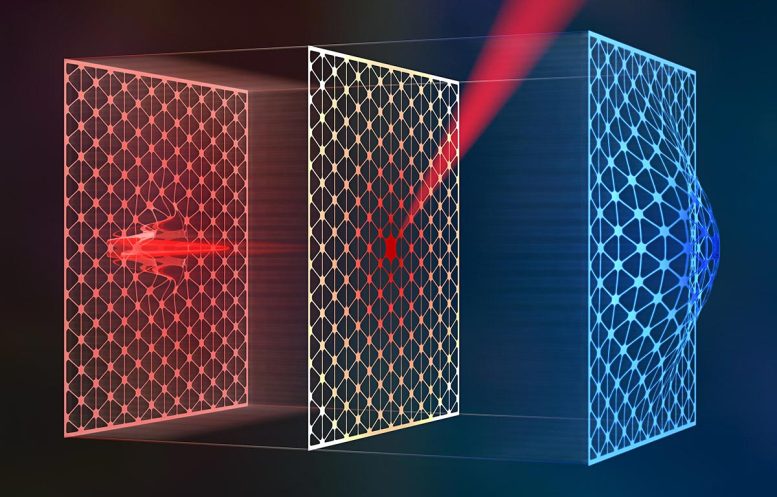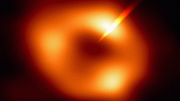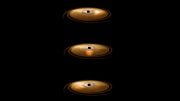
A SiN resonator under localized heating. Different modes have different effective temperatures depending on the spatial overlap between the local temperature and the dissipation density of the mode. Credit
Steven Burrows/Regal Group
Researchers discovered non-uniform temperature distributions in micro-mechanical resonators, impacting their design and performance in quantum science and precision sensing.
When measuring minor changes for quantities like forces, magnetic fields, masses of small particles, or even gravitational waves, physicists use micro-mechanical resonators, which act like tuning forks, resonating at specific frequencies. Traditionally, it was assumed that the temperature across these devices is uniform.
Temperature Variability in Resonators
However, new research from JILA Fellow and University of Colorado Boulder physics professor Cindy Regal and her team, Dr. Ravid Shaniv and graduate student Chris Reetz has found that in specific scenarios, such as advanced studies looking at the interactions between light and mechanical objects, the temperature might differ in various resonator parts, which leads to unexpected behaviors. Their observations, published in Physical Review Research, can potentially revolutionize the design of micro-mechanical resonators for quantum technology and precision sensing.
“In quantum science experiments, understanding this temperature difference’s ramifications will allow you to generate your mechanical quantum state with better fidelity and keep it unperturbed for longer, both essential starting points for quantum applications,” elaborated JILA postdoctoral research associate and first author Ravid Shaniv.
The Modes of Minute Measurers
Due to their flexible design, micro-mechanical resonators are a standard tool in many different fields of physics. These devices are often made of silicon or similar materials and can take various shapes: beams, cantilevers, membranes, or disks. Their small size allows them to oscillate at high frequencies, often in the megahertz (MHz) range to gigahertz (GHz).
The versatility of a micro-mechanical resonator’s design also allows physicists to fine-tune their oscillations. Just as a guitar string can vibrate in multiple ways (with the whole string moving back and forth or just parts wiggling while the rest remains still), micro-mechanical resonators can oscillate in different patterns or “modes.” The most familiar mode is the fundamental mode, where the entire structure moves in unison. But there are also higher-order modes, where other resonator parts move in more complex patterns.
To measure a resonator’s motion, physicists use laser beams. The resonator acts like a “moving mirror,” and the laser light that bounces off carries information about its position. When compared to light that bounces off a separate fixed mirror, an interference pattern is developed, revealing the resonator’s motion to ultra-high precision.
Over the years of observing these modes optically and discussing them with other physicists, Shaniv and Regal realized something interesting. “People have observed that some of these modes exhibit more thermal motion than others,” Shaniv stated. “Typically, people want to eliminate this motion as much as possible because it could overshadow any small effect they want to sense.”
Physicists have posited that this excess of thermal motion could be due to the resonator absorbing laser light in the form of heat. Different resonator modes can have different movement patterns, leading to varying areas of stress or strain, which can, in turn, lead to distinct magnitudes of thermal motion.
In many observations, the more complex the mode of the resonator, the more it’s thermal energy deviates from previous theories, which suggested the temperature for every mode was identical. Shaniv continued: “We wanted to track down the reason for that and how you can achieve the optimum design for these modes.”
Creating Temperature Profiles
To dive deeper into this temperature conundrum, Shaniv and Regal created specific temperature profiles for each mode. To do this, the researchers utilized a “phononic crystal” comprised of silicon nitride. The crystal acted as a playground where the researchers could engineer the resonator modes and generate varying temperature profiles, allowing them to observe the induced thermal motion of each resonator mode.
To create the temperature profile, the team heated a point on the crystal to very high temperatures while keeping the resonator edge at room temperature. After a profile was developed and thermal motion was measured, the researchers found some rather interesting results. Depending on the mode geometry, some modes showed increased thermal motion, while, even though parts of the resonator were extremely hot, others showed only mild heating, and some exhibited no heating at all. “By turning the knob all the way in the experiment, you could see this striking difference,” elaborated Regal.
Shaniv continued: “Looking at these really large temperature differences between modes, we were able to construct the temperature profile of a resonator directly from measured thermal motion and even find some material parameters that are typically not straightforward to evaluate, for example, the emissivity, which is how much radiation our device emits.”
By seeing which modes correlated to different thermal motions, the team could begin to predict how the resonators’ performance may change depending on their mode. As Regal explained: “A natural next step is to ask whether these concepts can be put to use not only in understanding how to keep resonators cold for quantum studies but also in thermal sensing.”
Designing Better Resonators
With the insights gained, the scientific and engineering communities could make significant strides in designing and applying these minuscule yet crucial devices. “We actually gave in our paper a real figure of merit, with which groups can work in this direction,” Shaniv elaborated. “For example, we now have a specific parameter to throw as a constraint into the computer and try to generate the best possible resonator.”
Reference: “Direct measurement of a spatially varying thermal bath using Brownian motion” by Ravid Shaniv, Chris Reetz and Cindy A. Regal, 6 November 2023, Physical Review Research.
DOI: 10.1103/PhysRevResearch.5.043121









If they break it – it wasn’t a good rule.